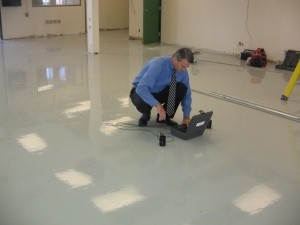No one likes a static shock, whether it is in your living room or at work. Ok, it honestly was pretty fun as a kid to slide across the carpet in your socks to see how much of a spark you could get grabbing the doorknob! In the real adult world, it isn’t a great experience. In settings such as a factory or distribution center with a lot of moving machinery, vehicles and elevated workers, static can cause real discomfort and genuine safety risk. Even in those environments without flammable materials or sensitive electronic components, the floor surface can be your friend or your enemy when it comes to controlling or eliminating a shock and the risks associated with them.
Nuisance Static is a Genuine Safety Risk
As an example, a large aircraft manufacturer with a very large facility was shut down by their safety group due to uncontrolled nuisance static. The facility coated the floor with an industrial urethane as a part of a 5S initiative. Because static electricity is generated by the contact and separation of materials, the soles of shoes and the vehicle tires touching against and separating from the polymer floor were creating problems. This contact and separation was the industrial version of rubbing a balloon against your head to make your hair stand up. In this case, the actual unit being assembled was grounded to and through the rail system. This made the aircraft itself the equivalent to the doorknob in the childhood carpet sliding experiment. The assembly team, supervisors and parts delivery staff were all receiving painful and startling shocks as they approached the aircraft and other grounded points. When someone lost their balance on mobile steps after receiving a shock by simply getting close enough to transfer the static built up on their body to the assembly, the entire process was deemed unsafe and immediate steps had to be taken to prevent this uncontrolled ESD event.
These events may seem inevitable or acceptable risk by some, but to most companies there is a real push to eliminate any unnecessary risk and discomfort from the workplace – especially those with an easy fix. Simple awareness and these basic steps can go a long way in avoiding the irritating and dangerous problems nuisance static will cause.
- Watch for, ask for and listen to employee feedback regarding static issues. If they are happening, people will be talking about it.
- Be aware of changing operating humidity in your work spaces. Low humidity will likely cause a dramatic increase in the buildup of static and require the use of ESD control for a safe discharge of all that electricity.
- Where needed, use ESD coatings and flooring to prevent static from building up. If the products used have a surface ground plane design (i.e. do not use a conductive adhesive or primer), you may not have to make any other changes to footwear and procedures.
- Work with a flooring contractor and/or manufacturer that are willing to test the floor at installation and on a regular basis to ensure it is functioning properly.
Are you experiencing static issues? Please comment below. We would love to hear your stories and descriptions of any problems caused by unwanted static shocks and what if anything you are doing to handle them.
- A Faster Cure for Flooring Needs: Polyaspartics in Action - April 8, 2025
- The Case for Epoxy Mortar in Manufacturing - April 8, 2025
- Epoxy Mortar Flooring: Built for Heavy-Duty Performance - March 29, 2025



